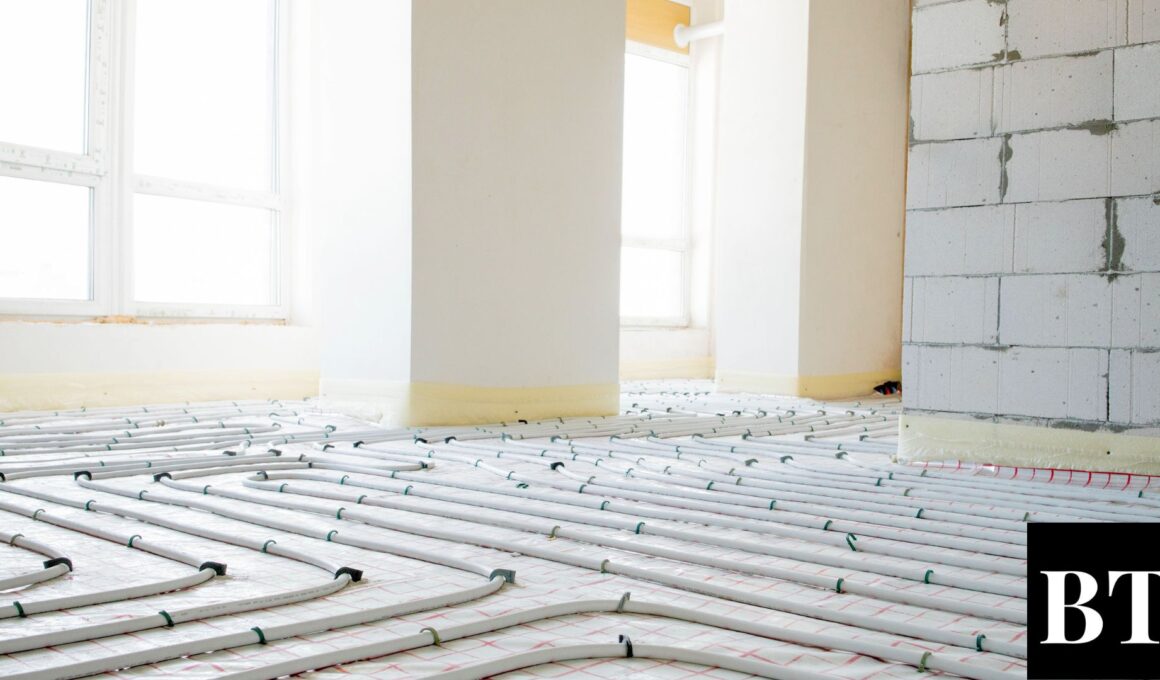Few heating systems generate as much excitement as underfloor heating. Its supporters claim that on it nothing is more pleasant than the feeling of warmth that comes with walking barefoot on the floor, and the heating bills are low. Its opponents, on the other hand, claim that the high price, the risk of failure and the restrictions on the choice of flooring are so daunting that it is better to bet on something else. Who is right? Is it worth installing floor heating in 2024? Let’s find out.
Can floor heating be installed in every home?
Unfortunately, the answer is no. The installation of underfloor heating should take place during the construction of the house, since it requires the installation of a new floor, which is usually costly and very unpleasant for the building’s occupants. Plans for how to provide heat to the interior should be taken into account already at the design stage, as not every type of floor will perform equally well.

It has been known for many years that the best flooring material for use with underfloor heating are ceramic tiles – they have a relatively low thermal resistance, while being long-lasting and offering great opportunities for personalization. It is also a relatively good idea to install a resin floor, but we would advise against buying parquet, as it is a good insulator. For the same reason, we warn – having floor heating, you should not have carpets, as they will reduce the efficiency of the entire installation.
How to prepare the floor for the heating system?
Installation of heating mats requires preparation. First of all, the floor must be level, smooth and clean, and the electrician must remember to prepare a proper electrical system.
An optional, though highly recommended, element is an additional layer of insulation, which is placed in front of the heating mats or tubes. It increases the efficiency of the entire system, which is, after all, what we care about. In most cases, you can choose between polystyrene and mineral wool, although polyinsulating foam (PIR) is also increasingly offered. Remember, however, that the insulation must be able to withstand frequent temperature changes and high pressure.
Recomended for you: Mastering the art of floors construction: A detailed guide
In which rooms is it worth installing underfloor heating?
A major advantage of underfloor heating is the freedom to choose its location. You can install heating mats both in the whole house, treating it as the main source of heat, and in a selected room or part of it, for example, in the bathroom.
Bathroom
The bathroom is the room where you should definitely install underfloor heating – it increases comfort and raises the air temperature, which to reduce the risk of mold. We do not know a person who would not be happy with warm tiles in the bathroom!
Kitchen
The kitchen is another place to install underfloor heating. Cabinets and other appliances cover the radiators, so the conventional heating method clearly loses efficiency. The kitchen is also a place where a relatively large amount of time is spent (much more than in the bathroom), so logically thinking, this is where it is worth betting on underfloor heating. At the stage of designing the installation, arrange the heating mats in places that will not be covered. This will increase the efficiency of your system.

Bedrooms
The bedroom is a place where we are particularly concerned about thermal comfort, and at the same time these rooms are usually not very large. For this reason, the installation of floor heating will not be too expensive. The big advantage of heating mats is greater thermal stability – radiators heat up to 60 degrees celsius, while the floor is only slightly warmer than the air in the room. Keep in mind, however, that floor heating under a closet, low bed or dresser will have a relatively low or even zero efficiency.
Living room
Due to the large area of the room, installing underfloor heating in the living room can be expensive. Admittedly, the whole process is simple, since few people keep cabinets and other furniture adjacent to the floor in the living room, but it is worthwhile to approach the subject economically and not install heating mats over the entire floor area. First of all, heating elements should be separated from the walls – the suggested distance is about 30 centimeters / 1 foot. Also, plan the place where the couch will stand, as it does not make sense to heat the floor directly under it.
Is floor heating expensive?
Well, floor heating can be both cheap and very expensive. The cost of installation depends primarily on the area of your house – the larger it is, the more you will have to pay, although the price per m^2/ sqft will be lower.
So, how much does floor heating cost? For electric floor heating, the price per square meter ranges from $80 to $120 (including installation), while for water underfloor heating, costs will rise to $150-$180 per square meter. An additional cost is the purchase of a suitable thermostat – the more expensive it will be, the more efficient it will be, as a rule. This is another expense in the $50-$150 range.
Which type of underfloor heating is better? Electric vs water heating system
When choosing floor heating you have two main options – electric-powered heating mats or water heating, using tubes. Both solutions have advantages as well as disadvantages that must be taken into account.
Electric underfloor heating
As a rule, electric heating is cheaper, less efficient and simpler to install. Heating mats require quite large amounts of electricity, so we recommend this choice to people who have solar panels – then, heating the house becomes cheap. It is also worth remembering that this solution is simpler to install, which is especially important when renovating existing houses.

The big advantage of electric floor heating is that there is no need to vent the ductwork and the room can be heated as well as cooled faster.
Water underfloor heating
The second option is water heating – this is a system of parallel tubes through which hot water flows, giving up its energy to the environment. This is a more expensive, though clearly more efficient solution. Very importantly, the tubes can be combined with a heat pump, which significantly reduces the cost of heating the house.
Recomended for you: The science of concrete floors: A comprehensive study
Is underfloor heating safe for health?
There have been many myths surrounding this topic – some say that underfloor heating is not very good for people with respiratory diseases and allergies, because there is more dust in the air. This is partly true, and if you opt for this type of heating, you have to reckon with the need to clean your home more often.
On the other hand, underfloor heating can improve comfort – classic radiators make the air much drier, which can lead to dry nasal mucous membranes in more sensitive people. An additional advantage is greater stability of room temperatures, which is important when it comes to common illnesses such as the flu and the common cold – by choosing underfloor heating, you reduce the risk of getting sick, as thermal shocks greatly weaken your immune system.
Is it worth replacing radiators with underfloor heating?
Well, all indications are that yes, however, such a decision may be more or less profitable. If, along with the installation of underfloor heating, you also plan to install a heat pump, you will probably feel a marked difference in your energy bills. Replacing your heating system will also pay off if you have a photovoltaic system, since the energy it produces should cover the consumption generated by the heating mats.

Keep in mind, however, that the installation of underfloor heating can be expensive – in many cases, the total cost will exceed even $10,000. Think carefully about whether you can afford it.
Read more:








